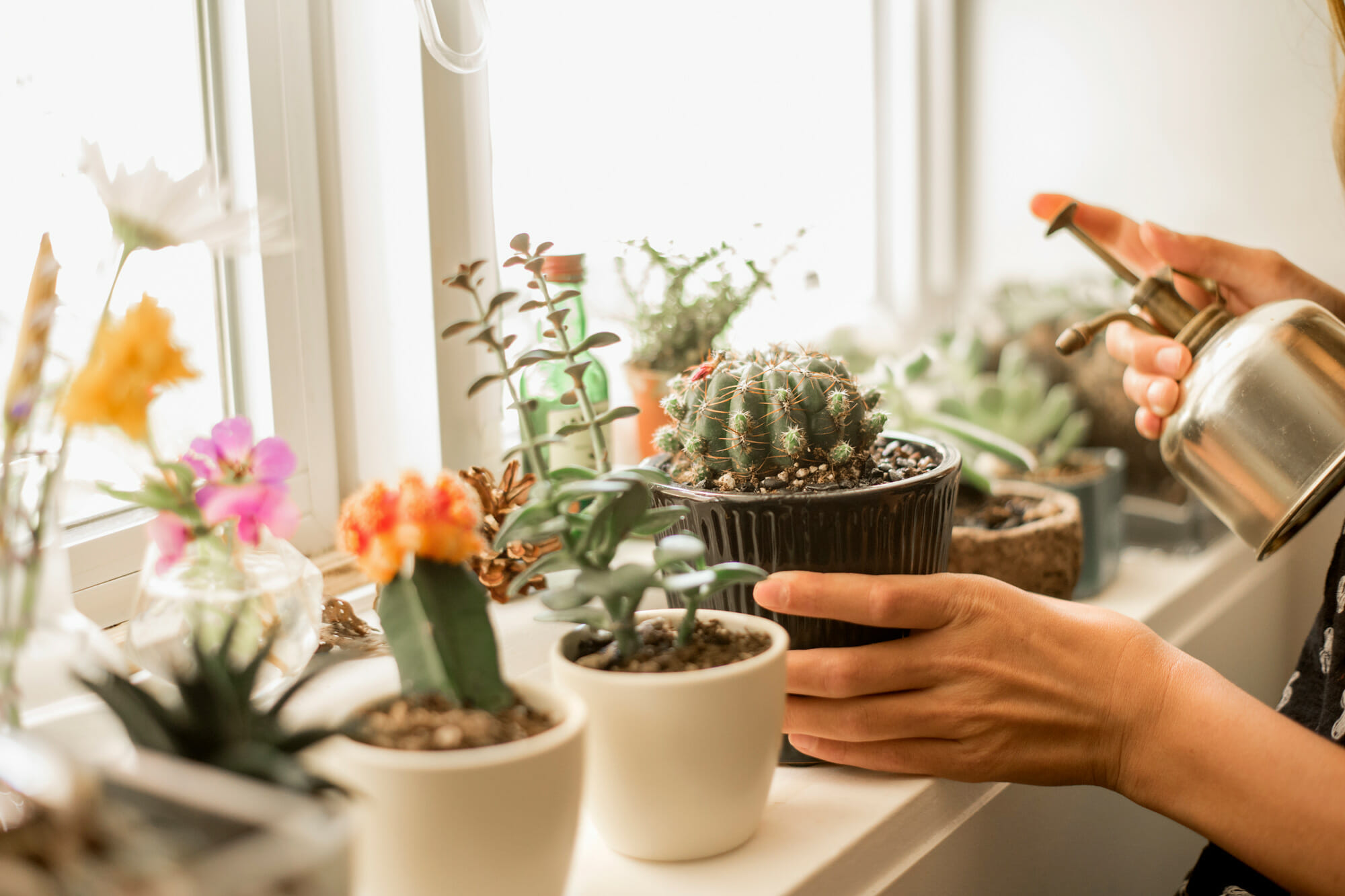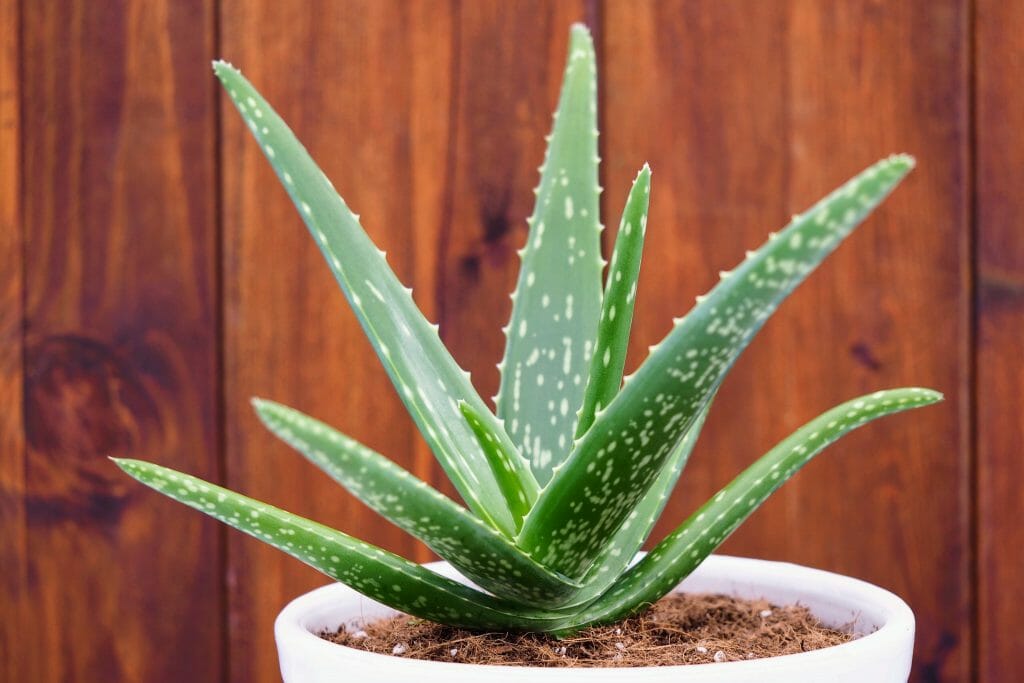Succulents all require differing, specific amounts of sunlight to thrive. The different succulent species range from aloe to cacti to echeveria. Like all other plants, they grow by absorbing light and converting it into energy via photosynthesis.
How much light do succulents need? The average amount of light they need is between 4-6 hours a day. Since there’s always going to be less sunlight indoors than there is outside, your succulent will likely take longer to fully mature than it otherwise would out in the desert.
Succulent plants are fleshy, thick, and can look enlarged; they’re adapted to hold water in dry climates and thus look the part. True to their name, succulent (originating from the Latin name “succus” which refers to sap or juice), succulents absorb and store water in sap form for use during dryer months.
Especially in recent years, succulents have taken over the hearts of plant lovers, crafters, and interior decorators the world over. So whether you’ve been gifted a jade plant or you picked up an echeveria at the store, it’s imperative that you learn to care for your new friend properly. Let us show you how!
Succulents in Sunlight or Natural Lighting
Many succulents have become highly adapted to living indoors, so even the most helpless plant mom or dad can successfully grow one as long as they can provide the right environmental conditions. This goes for other house plants you may be growing as well. But do succulents need light, and is it possible to grow them indoors?
Succulents require a specific amount of sunlight to blossom, though this varies from species to species. All plants develop by absorbing light and converting it into energy using a process referred to as photosynthesis.
It can be tough to offer sufficient light to your succulent if you don’t have windows facing the ideal direction, and you might not know whether or not they’re getting enough light until the physical signs appear, like drooping or wilting.
Plainly put, when succulents don’t obtain sufficient light, they won’t grow appropriately. While they’re considered hearty plants, they still need care and attention. Ultimately, succulents that receive insufficient light develop into distorted, discolored, and weak plants.
Proper lighting is important, and while a succulent’s water requirements can be different from a traditional plant, light is a key part of the equation.
Instead of placing that brand-new TV over by the window, try designing your naturally-lit spaces around your favorite plants so you can make sure they get the sunlight they need.
DON’T MISS: Check out these amazing bear paw succulents!
Beware though — your succulent can actually get too much light. Just like people, they can wind up with a nasty sunburn. A sunburned plant is no good, and unsightly spots and marks can show up. In fact, your succulent could even die if left to burn in the sun for too long, so be sure to research the specific lighting requirements of your plant and move them away from the window once they’ve hit their limit.
Thankfully, natural sunlight isn’t a plant owner’s only option.
We stumbled across this wonderful video from Succulent Fame on the amount of light succulents need, take a look!
Can Succulents Survive in Low Light?
Succulents generally require a minimum of four to six hours of sunlight so that they can grow appropriately. Since there’s less sunlight available indoors than outdoors, houseplants will take more time to mature.
Considering their extreme hardiness, succulents can survive in the shade or a low-light environment but often won’t flourish. After a while, plants in these conditions, in the absence of appropriate sunlight, can die or wither. They’ll often try to stretch towards any source of sunlight, and this will make them thin and elongated in appearance, with stunted growth.
Start by researching each species’ exact lighting requirements and base your purchase around whatever level of sunlight you’re able to provide effectively. Plants that come from different locations around the globe are adapted for different environments, so consider the climate you live in if you plan to have the windows regularly open, as colder air can kill a succulent pretty quickly if left unchecked.
While you may not have to worry specifically about frost when the plants aren’t in the ground, cold weather is still a no-go for even the hardiest plant.
When you’re unable to develop appropriate lighting conditions in your home no matter what you try, you can always turn to technology to give a helping hand. Artificial lights that mimic the properties of sunlight can be perfectly sufficient in keeping your plants happy and healthy.
DON’T MISS: 17 STUNNING types of Jade Plant!
Grow lights
Grow lights, or artificial lights, are designed to emulate sunlight to assist in plant growth, stimulating them and inducing photosynthesis. They can be used as complementary light when there is just a little less sunlight than you need, or they can serve as the primary source of light for all sorts of houseplants. Diverse grow lights are intended to either imitate the light spectrum or provision of a color spectrum that is precise to a particular plant’s requirements.
Outdoor lighting conditions are most optimally reproduced indoors through the use of grow lights, with features such as changing temperatures, lumen strength, and color ranges. It can be confusing to pick the correct grow light, but it’s worth it in the long haul. They’ll set you on the path to being a successful indoor gardener.
- You’ll need to find just the right amount of sunlight for your specific succulent. Plants require a certain amount of light for photosynthesis to take place. In the case of succulents, you’ll need grow lights that radiate a minimum of 2,000 lumens per square foot.
- The higher the light’s wattage, the higher your electric bill will be. If this is a concern for you, you’ll need to look for energy-smart lighting solutions that will give sufficient brightness at an affordable price point.
- Sunlight covers a pretty big spectrum of light. Indoor plants will grow best under full-spectrum bulbs, which mimic natural sunlight and offer a balance of warm and cool tones, giving a similar experience to plants thriving outdoors. The best color temperature for succulents is a minimum of 5,000 kelvins, which provides succulents with full-spectrum light, effectively mimicking sunlight.
- It’s essential to estimate the heat the light radiates. When things are too hot, your plant may experience a burn or scorching effect. Conversely, as we mentioned before, keeping things too cold can be even worse than too hot, and a plant in a cold environment can perish rather quickly. Make sure your succulent is at an appropriate distance from any light source to avoid burns! We figure that unless you’re an astronaut, you’ll be far enough away from the sun.
- Growing indoors under grow lights, one is required to follow the same basic watering guidelines recommended for succulents grown outdoors. In summer seasons, one should only water succulents when their soil is dry. You can determine whether or not the soil is sufficiently dry by sticking a finger in the soil at least an inch deep. When it’s cooler out, water the plants less to mimic the ways that they act in the wild.
How do I know if my succulent needs more light?
If your succulent is looking pale or has stretched out, it may need more light. Another sign that your succulent needs more light is if the leaves are falling off. If you see any of these signs, move your plant to a location with more light.
In general, succulents need about 6 hours of direct sunlight per day. If you live in an area with very hot summers, you may need to provide some afternoon shade for your succulents. During the winter, they will need less light and can tolerate some shade.
If you are unsure whether your plant is getting enough light, try using a light meter to measure the amount of light it is receiving. A light meter can be found at most hardware stores or online.
Once you know how much light your plant needs, you can adjust its location accordingly. If possible, move it outdoors to a sunny spot for part of the day.
Frequently Asked Questions
Can succulents get too much light?
Most succulents require a minimum of three hours of direct sunlight every day, and more if they’re generally found in an outdoor environment or when sunlight is directly penetrating through the window. Succulents can be injured when there is too much direct sunlight, so be careful to avoid sunburns, or else they might form scars on the surface of their leaves.
During harsh times in hot summer, offering filtered sunlight is ideal for succulents. You can also move the plants depending on the time of day, just find what works best for you!
Do succulents like to be touched?
The most sensitive part of a succulent is its leaves. You should generally avoid touching the succulent leaves if possible, but if you do, it won’t be the end of the world. Just make sure you don’t give a handshake to a super prickly one! When dealing with roots in the re-potting process, be sure to exercise caution so you don’t rip anything.
How long can succulents go without water?
Generally, small home-based succulents can survive by being watered once or twice a week. They can go without water for up to two weeks without showing any visible signs of stress. When a plant undergoes 14-30 days without being watered, it may start to shed excess growths such as leaves, branches, or thorns.
Growing Healthy Succulents
The amount of light that succulents need to thrive depends on the species, and it can be quite different. With their exceptionally beautiful colors and shapes, succulents contribute to a gorgeous potted plant.
Offering sufficient light during the growth of indoor succulents can be a tough task, and it may require a bit of research to get everything right. When succulents do not obtain sufficient light, they will not grow properly and could die before you really get to enjoy their presence.
Always take note of how your little friend responds to different levels of light to keep them happy and healthy for as long as possible!





